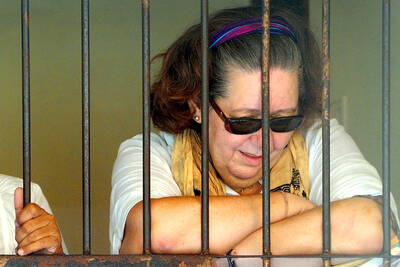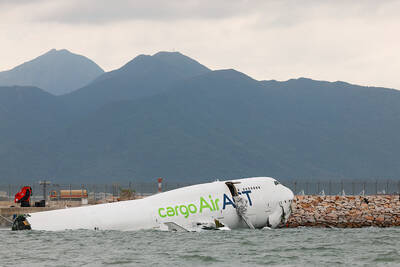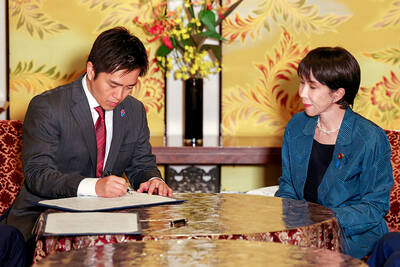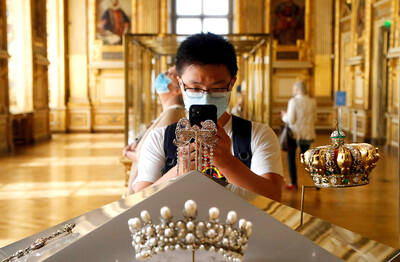Police in riot gear invaded an old Indian museum complex on Friday and pulled out a few dozen indigenous people who for months resisted eviction from the building, which will be razed as part of World Cup 2014 preparations next to the legendary Maracana soccer stadium.
Some of the squatters went peacefully. Others were handcuffed and dragged from the building.
They were transported to temporary housing provided by the government. Officials have said they will build a new Indian cultural center that could provide housing, but that it will not be complete for another 18 months.

Photo: Reuters
As the Indians were removed, a large group of their supporters clashed with police, who then used tear gas, pepper spray and rubber bullets to push protesters back.
About half an hour after the police entered the museum, all the Indians were out of the building and the protesters mostly dispersed. Police were seen on the roof as scores of others secured the perimeter on the ground.
The museum has been at the center of a drawn-out legal battle between the squatters and state and local authorities, who want to destroy the complex as part of renovations ahead of the World Cup. Maracana will also host the opening and closing ceremonies of the Olympics.
Officials have not said exactly what would replace the museum, but they have said the area will see a new parking lot, commercial center and expanded stadium exits.
The indigenous group included men and women of about 10 ethnicities, mostly Guarani, Pataxo, Kaingangue and Guajajara, who lived for years in 10 homes they built on the site of an old Indian museum abandoned since 1977.
Gabriel Guajaja, a 23-year-old law student wearing an Anonymous mask and brandishing a Brazilian flag, said he turned out to support the Indians holed up in the museum.
“It’s been 500 years that white men have been exploiting the indigenous people of this continent,” Guajaja said. “The local government wants to destroy even this little bit of Indian culture we have here in the city. It’s disgraceful.”
Earlier, from inside the complex, Indians in face paint and feather headdresses negotiated with police and local government officials as others beat out a rhythm on pans. At one point, the Indians held an infant above the wall of the complex to show negotiators the baby was holed up there.
A woman held a homemade sign reading: “they won’t pass.”
Blighted streets around the stadium are also to undergo a transformation to become a shopping and sports entertainment hub.
Most of a nearby slum, about 500m away from the museum, was demolished to make way for the new development.
Rio de Janeiro Governor Sergio Cabral told a news conference in October last year that the building’s razing is necessary for hosting the World Cup.
“The Indian Museum near the Maracana will be demolished,” Cabral said then. “It’s being demanded by FIFA and the World Cup Organizing Committee. Long live democracy, but the building has no historical value. We’re going to tear it down.”
However, a letter from FIFA’s office in Brazil to the federal public defender’s office, published in January by the newspaper Jornal do Brazil, said that the soccer authority “never requested the demolition of the old Indian Museum in Rio de Janeiro.”
The squatters believe they have history and the law on their side.
The crumbling mansion with soaring ceilings that housed the old museum was donated by a wealthy Brazilian to the government in 1847 to serve as a center for the study of indigenous traditions.
After the museum closed more than three decades ago, Indians of various ethnicities started using it as a safe place to stay when they came to Rio to pursue an education, sell trinkets in the streets or receive medical treatment.

Indonesia was to sign an agreement to repatriate two British nationals, including a grandmother languishing on death row for drug-related crimes, an Indonesian government source said yesterday. “The practical arrangement will be signed today. The transfer will be done immediately after the technical side of the transfer is agreed,” the source said, identifying Lindsay Sandiford and 35-year-old Shahab Shahabadi as the people being transferred. Sandiford, a grandmother, was sentenced to death on the island of Bali in 2013 after she was convicted of trafficking drugs. Customs officers found cocaine worth an estimated US$2.14 million hidden in a false bottom in Sandiford’s suitcase when

CAUSE UNKNOWN: Weather and runway conditions were suitable for flight operations at the time of the accident, and no distress signal was sent, authorities said A cargo aircraft skidded off the runway into the sea at Hong Kong International Airport early yesterday, killing two ground crew in a patrol car, in one of the worst accidents in the airport’s 27-year history. The incident occurred at about 3:50am, when the plane is suspected to have lost control upon landing, veering off the runway and crashing through a fence, the Airport Authority Hong Kong said. The jet hit a security patrol car on the perimeter road outside the runway zone, which then fell into the water, it said in a statement. The four crew members on the plane, which

Japan’s ruling Liberal Democratic Party (LDP) and its junior partner yesterday signed a coalition deal, paving the way for Sanae Takaichi to become the nation’s first female prime minister. The 11th-hour agreement with the Japan Innovation Party (JIP) came just a day before the lower house was due to vote on Takaichi’s appointment as the fifth prime minister in as many years. If she wins, she will take office the same day. “I’m very much looking forward to working with you on efforts to make Japan’s economy stronger, and to reshape Japan as a country that can be responsible for future generations,”

SEVEN-MINUTE HEIST: The masked thieves stole nine pieces of 19th-century jewelry, including a crown, which they dropped and damaged as they made their escape The hunt was on yesterday for the band of thieves who stole eight priceless royal pieces of jewelry from the Louvre Museum in the heart of Paris in broad daylight. Officials said a team of 60 investigators was working on the theory that the raid was planned and executed by an organized crime group. The heist reignited a row over a lack of security in France’s museums, with French Minister of Justice yesterday admitting to security flaws in protecting the Louvre. “What is certain is that we have failed, since people were able to park a furniture hoist in the middle of